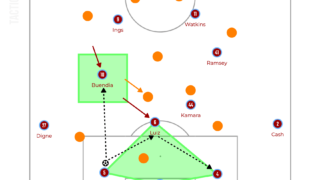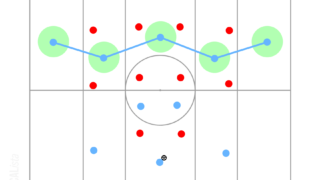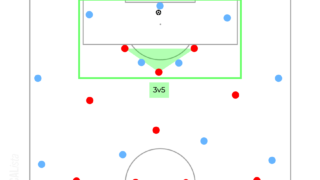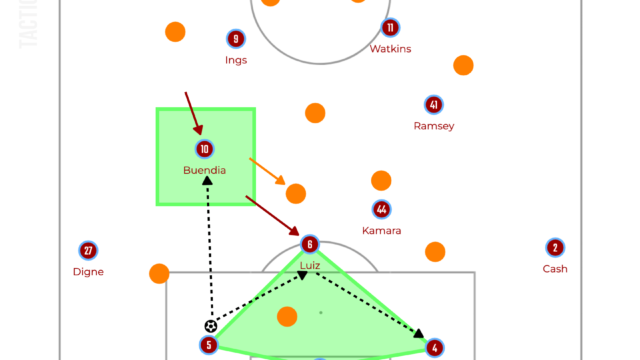Overview
Aston Villa are one of the clubs who are threatening the ‘big six’ clubs at the moment along Newcastle, Brighton or West Ham. They earned the spot of the UEFA Europa Conference League last season, and it is just the beginning of their journey. The changes of the board including welcoming ex Sevilla sporting directer Monchi who has already helped Unai Emery this summer were also important for them as they signed Pau Torres from Villarreal and Moussa Diaby from Bayer Leverkusen. Both players have already played important roles, which made the team more stable and aggressive in possession.
The overall structure has not changed so much, and Emery successfully has built more things upon his basic style. The 4-4-2 with narrow wide midfielders is constantly working well thanks to skilful players at the back and also powerful and pacy attackers up front. Emery’s iconic defensive structure with the extreme high back line has a risk, but in fact they have beaten Brighton by 6-1 thanks to their organised pressing which stopped one of the best teams in teams of playing out from the back.
In this article, Aston Villa’s tactics of both in and out of possession are going to be analysed in detail. I hope you will enjoy this article.
If you are interested in the analysis of their tactics last season, the article below is the one.

Build up
When playing out from the back, they have many players who have composure on the ball including the goalkeeper Emiliano Martínez, which helps them stop the opposition feet and progress the ball effectively.
The basic system is a 4-4-2 with narrow wide midfielders, John McGinn, Nicolò Zaniolo or Leon Bailey. They position themselves in between the lines and receive a split pass from the centre backs. In addition to this pattern, thanks to the narrow positions of the wide midfielders, there is huge space in wide area where Ollie Watkins drifts to receive a long ball. However, to play forwards comfortably, they need to create a spare player at the back, and this is their strength.

At the back, the first movement is often performed by one of the defensive midfielders who drops between the opposition strikers. This movement can offer a passing lane for the goalkeeper or centre backs to play through the middle, which is extremely important. If the ball is only played from one centre back to the other via the goalkeeper, the opposition easily anticipate and accelerate to apply pressure on the ball. However, if the ball can sometimes be played through, the opposition will be forced to stop shuffling across smoothly and change the body angle, which decreases the intensity of their pressing. Moreover, not only the opposition midfielder who follows the dropping defensive midfielder but also the striker can be attracted to the ball in the middle, which gives space and time to the ball side centre back, who is Torres in the illustration above.
This is the first step to stop the opposition pressing and create a spare player at the back. However, if the centre back on the ball spoils the advantages, everything will be broken. In terms of utilising space and time effectively, Villa’s centre backs are excellent, but Torres is one of the best in the league. He can step in to progress the ball or play through or over depending on how the opposition fullback defends, and the accuracy of his distribution is brilliant.
In case the opposition fullback tightly follows the narrow wide midfielder, there is a space in behind and Watkins drifts outside and receives a long ball. He can hold the ball up or even face forwards thanks to his physical superiority and this option is extremely important because the ability of progressing the ball by playing over makes it difficult for the opposition to press high. If the opposition fullback hesitates to leave his position, the narrow wide midfielder can receive the ball in between the lines.
In the midfield, the system is tweaked. From the 4-4-2, it turns into a 3-2-5, but there are various ways to change the back four to back three. The key is the number of centre backs at the back and the position of Matty Cash.
If there are two centre backs and Cash plays as the right fullback, there are two options. When Bailey plays as the right midfielder, Cash stays deeper and the left fullback Lucas Digne steps higher.

The next option is, when Zaniolo and McGinn play as wide midfielders instead of Bailey, Cash also moves higher and Boubacar Kamara drops into the right side to cover the space where Cash left and form the back three. Additionally, McGinn drops next to Douglas Luiz to make it the double pivots.

Finally, when there are three centre backs who are the usual two plus Diego Carlos in the middle, Cash plays as the wide midfielder of the 4-4-2 and stays higher in possession.

This is one of the characteristics of positional play, which is keeping the balance of the shape while changing the players. This ensures stable attacking patterns in the system and also a 3-2-5 is one of the most balanced shapes in possession. If you would like to explore about positional play more deeply, please find the article below.

In the next chapter, the attacking patterns in the final third are going to be analysed in detail.
Final Third Attacking
In the final third, they can play through the middle extremely well thanks to the stable structure. Even though they have five players up front, they are not fixated in each lane. The central three attackers keep close each other and as soon as receiving a split pass from a player at the back or defensive midfielder, they quickly link up and attack the middle. Especially, Diaby is extremely good at not only just receiving the ball in the right pocket but also turning forwards and carrying it.
Another method is using Watkins as a third player. He can drop slightly to receive a split pass from a defender and lay it off to one of the attackers in the middle or defensive midfielders. This helps them to face forwards without turning forwards, which means it becomes easier to let them face forwards.

The close distance each other in the middle of the shape helps them combine extremely well and the ability of exploiting the middle is important to force the opposition to close the middle, which makes it easier to exploit the space in wide areas.
From wide areas, they prefer to deliver crosses as soon as possible. If the wide players, often Cash and Digne, have time and space, they deliver crosses into the box and most of them are low crosses towards the space in front of the opposition back line. The receiver of the crosses is often the opposite inside attacker and he stays in front of the opposition back line to gain space to take a shot from a cut back.

As soon as the wide player receives the through pass, even though other players and opponents make straight runs towards the box, the opposite inside attacker makes a diagonal and late run to stay in the huge gap between the opposition defenders and midfielders. This is one of their principles and they scored many goals from this pattern.
In case the wide player can progress into the deep area of the box, the opposite inside attacker keeps running and receives a short and sometimes chipped cut back at the first post.

Initially, the inside attacker, McGinn in this situation where he scored against Everton, stays his position in front of the opposition back line to prepare for a cut back, but as soon as the winger penetrates the box, he changed the direction and received the chipped cut back at the first post. He scored against HŠK Zrinjski Mostar in the Conference League in the exact same pattern.
As it was discussed, these patterns are mainly when they could play in behind from wide areas and attack the box quickly. However, against a low block, the space for cut backs are often closed and they need to make something. The key is a combination in wide areas. In the left side, when Digne possesses the ball, the inside attacker makes a run in behind. It has been recently done by Zaniolo and he is a dynamic player who can cause the opposition defensive block problems, so if he is suspended for the betting scandal (still unsure at the moment when I am writing this article), it will be a concern for Villa. Additionally, in the right side, Cash is an important to player to cause the opposition problems. He can take on the opposition fullback like a winger and even when he plays as a part of the back three, he makes an aggressive run into the box and directly involves goals.
Overall, in possession, their build up is as good as last season thanks to the structure and the individual abilities such as Watkins, Torres or Martínez. Additionally, in terms of attacking the box, they have clear and effective patters to score goals, so there are no doubts in players, and they execute them so quickly. The positional play approach sometimes causes arguments such as it limits the players’ ability, but Emery maximises the qualities of his players and that is why they can challenge the big six clubs.
Pressing
Emery’s pressing is very unique and the extreme high back line is his trademark. Firstly, Villa’s pressing against the opposition goal kicks is going to be discussed.
The basic shape is a 4-4-2 out of possession, but it becomes a 4-diamond-2 against the opposition goal kicks. Luiz steps up and marks the opposition defensive midfielder while Kamara stays deeper as a pivot.

This works extremely well against Brighton and they smashed them by 6-1. The strength of this approach is analysed in another article because many teams have pressed with this shape against Brighton, so it was analysed exclusively.

When pressing high in open play, the basic system is a 4-4-2 and the back line tends to remain as higher as possible. The defenders hardly follow the opposition movements in behind and try to make them offside. Sometimes their wide midfielders drop into the back line, so it is often referred as ‘the back six’, but the reason is their reference of marking.
Usually, when they press high, it remains the 4-4-2 and focuses on preventing the opposition from playing forwards. When the opposition plays to a fullback or wingback, the wide midfielder presses with cutting a passing lane to play forwards, not from the inside to the outside.

When pressing, in other words when the opposition tries to play forwards, the objective should be preventing them from playing forwards. Pressing from the inside to the outside is also useful to lock them in, but it has a risk because the opponent can carry the ball forwards or play through. On the other hand, by applying pressure from the opposition fullback’s front, he cannot play or carry the ball forwards. This is the principle of Emery’s team.
Therefore, the reference of the wide midfielders is the opposition fullbacks or wingbacks, and the objective is preventing them from playing forwards. This is the reason why they often drop into the back line. As the opposition fullback moves higher, the wide midfielder follows the movement to press him from his front.

Another possible reason can be they do not want to make a gap in the back line. This is because sometimes it is one of the defensive midfielders to drop into the back line to make it the back five. This situation occurs when the opposition fullback is not high, which means the wide midfielder does not need to drop, and one of the opposition inside attackers makes a run in behind.

The centre backs hardly move away from the middle so that they can focus on just moving up and down to control the height of the back line, so it is going to be a task for the defensive midfielders to close the gap between the centre back and fullback. However, even from this example, it is possible to say that the reference of the wide midfielders is the opposition fullback.
Obviously, this high line has a risk. They have conceded numerous goals by being exploited the huge space in behind, but this is something they can do nothing if they pursue their style. Preventing the opposition from playing forwards with players’ pressing direction and the rule of offside is Emery’s identity.
Final Third Defending
When defending against crosses, which is one of the biggest features of defending in the final third, they share many principles with pressing higher, so the weakness is same. The back line is too high.
The basic structure hardly changes in the final third, so the centre backs stay in the middle and the ball side defensive midfielder closes the gap between the centre back and fullback, or the wide midfielder drops into the back line. The back line is extremely high, and it is sometimes level with the height of the ball.

Like in the midfield, the back line seeks to the timing to push the line higher and constantly steps up with side steps as soon as the opposition plays back. However, when the opposition delivers crosses, the back line stops and is not ready for moving back. This is a problem if they cannot get an offside. Many teams push the line up frequently, but they must be ready for dropping back when a cross is delivered and just hoping that they can manage to get an offside is a high risk. In fact, they conceded many goals by being exploited the space in behind, so they need to improve when to drop the back line to clear a cross not only just pushing the line up.
Overall, their unique style of defending has an advantage and disadvantage. However, it seems that the disadvantage is effectively exploited by the opposition this season. Therefore, they must improve this element to get the spot of the European competition this season again. Thanks for reading. I hope you enjoyed this article.



